- Author: Ashley Van Vliet
- Author: Kathleen Reyes
- Author: Vonny M. Barlow
Entomologist, Dr. Vonny Barlow of the University Cooperative Extension is in the process of continuing his research with Euschistus servus, or Brown Stink Bug (BSB),in cotton. Results from Barlows' studies have contributed to more effective management of BSB in Southern California.
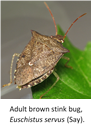
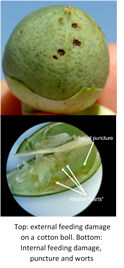
In the eastern states, primarily Georgia, boll rot and cotton staining created by the BSB has become a substantial issue. Initially there was fear that BSB and associated boll rot could cause significant cotton losses in California which prompted many to make chemical applications. In fact, these chemical applications exceeded the regular 3-4 insecticide applications every season, sometimes substantially.
Dr. Barlow is currently in the second year of his experiment which he began over 1 month earlier than in 2015. Three commercial cotton fields were selected to establish experimental plots. Among the three fields, sixteen sampling 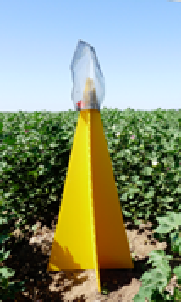
At each sampling locations three data points are gathered. The first data sampling consisted of recording the number of BSB taken from each pheromone trap every seven days. Next, sweep samples consisting of 20 sweeps per trap location are collected and sorted in the laboratory for total numbers of BSB. Finally, stink bug damage to cotton bolls is assessed with 10 cotton bolls per each trap location selected and taken to the lab were they are “cracked”, and processed for; external and internal feeding punctures, stained cotton lint and presence of boll rot. By the end of the season we will have hand processed over 7,000 cotton bolls for this project.
The results of the experiment during the first year demonstrated that there is no significant aggregation of BSB along cotton field perimeters, contradicting what was previously predicted. Pheromone traps yielded greater stink bug numbers than sweep sampling over the same time period. However, the use of pheromone trapping is intensively laborious. It was also demonstrated that the use of 20% internal boll “warts” was not a useful indicator for “triggering” a chemical applications since it was shown that there is no relationship between presence of internal boll warts and cotton boll rot. It appears that even though boll warts when present, are not a “pathway” for bacteria that causes boll rot in Southern California. This may be due to the sometimes harsh environment of California's southern desert which may make the cotton plant leaf surface inhospitable to bacteria. Altogether these findings suggest that insecticide applications for the BSB in Southern California does not need to take place, saving growers from costly applications every season.
- Author: Peter B Goodell
Useful Resources:
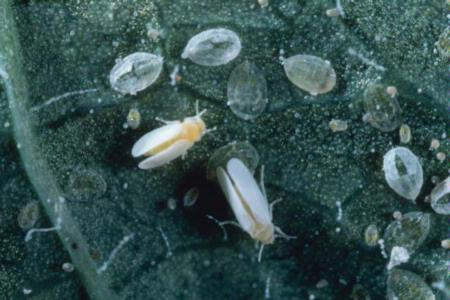
- UC Pest Management Guidelines for Cotton
- Whitefly Management Guide
- Whitefly Webinars, Plant Management Network
August is the typical time for change in managing cotton pests in the San Joaquin Valley. As the plant is shifting from setting fruit to maturing fruit and our attention is shifting from protecting yield to protecting quality. Lygus becomes much less of a concern as bolls mature beyond 10 days after flowering and our attention focuses on preventing excessive honeydew from drifting down onto open bolls and exposed lint.
Minimizing the occurrence of sticky cotton remains a critical goal for San Joaquin Valley cotton. Close attention to fields

In the past several years, a resurgence in sweetpotato whitefly biotype B (formerly silverleaf) has been experience in the San Joaquin Valley. I am noting a very preventative approach in managing whitefly with treatments being applied at very low population densities. The concern for sticky cotton is real and the response to prevent it is understandable.
PCAs and growers should consult regularly to review their individual situations, determine a course with the remainder of the season in mind, and select insecticides based on the threat, the population composition and insecticide resistance principles.
There is a good collection of information available and the interested pest manager is directed to these list above for more details.
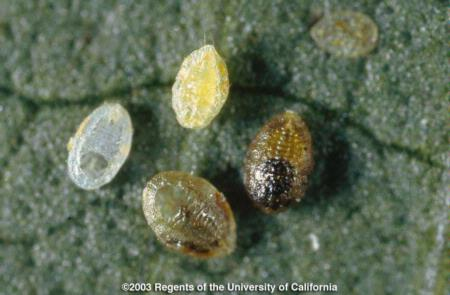
- Author: Peter B Goodell
There have been numerous reports of pale striped flea beetle in cotton around the Five Points area of Fresno County. Population densities of 20-30/50 sweeps have been found, causing some concern among PCAs. The most common species is the pale striped flea beetle, Systena blanda.
In most cases, flea beetle is usually a problem on seedling cotton, not on blooming cotton according to IPM Manual for Cotton in the Western US.
The manual states: "Flea beetles, small beetles with enlarge hind legs that enable them to jump, chew small round holes or pits in cotyledons and young leaves. They 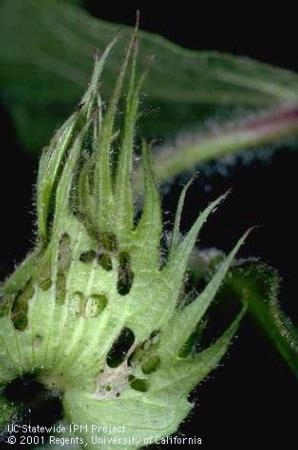
However, given enough beetles moving into a cotton field at one time, damage can occur. One field I observed in late July had over 500 beetles for 50 sweeps and caused considerable leaf damage in the lower canopy. The source of beetles were neighboring alfalfa fields which were recently cut and water stressed.
Damage to the leaves was mainly superficial feeding. Leaves were not tattered nor did they display
While not normally a damaging pest to mature cotton, high population densities of pale striped beetle can potentially cause damage at any stage of growth.
- Author: Peter B Goodell
- Monitoring Lygus in cotton
- Stripping alfalfa hay
- Movement of Lygus in the Landscape
- Natural enemies in cotton
With growing conditions continuing to look favorable for cotton growth and development, fruiting is beginning or well underway in some locations. Fruiting is being noticed in Firebaugh area at 6th main stem node, which is line with early season temperatures we have experienced and good planting dates.
Setting the early fruit sets the plant up for the rest of the season. With a shortage of the irrigation deliveries this year, the season must be as compact as possible. Protecting early fruit is critical in these water short conditions.
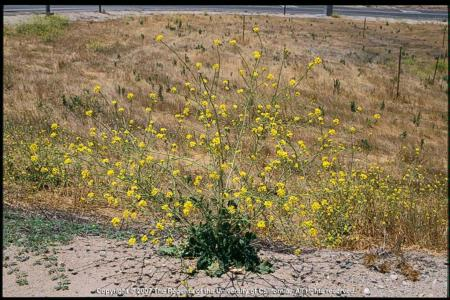
Lygus will be a localized problem. Movement will occur from neighboring sources, most likely other cultivated crops. Key sources for Lygus include safflower, forage alfalfa and seed alfalfa. Within safflower and alfalfa forage, the Lygus population can be managed to prevent mass movement into surrounding cotton fields. Lygus is closely managed in seed alfalfa can still acts as a major source.
Safflower is currently being treated for Lygus to prevent the first generation from 
Alfalfa forage is the most common crop which Lygus prefers. It is a unique crop in our cotton landscape because it is harvested frequently for its vegetative biomass, not its reproductive parts, e.g. fruit, lint, seed. Providing even a limited habitat during cutting can have a substantial effect on mitigating Lygus movement into cotton. During the June and July cuttings, if uncut strips of alfalfa are left in the field, Lygus will move to them and stay until the next irrigation cycle, when they return to the larger alfalfa field.
Limiting the movement of Lygus into cotton not only protects the fruit during this critical early stage but can reduce the need for insecticide applications. This allows additional natural enemies to build and helps reduce pressure for the development of insecticide resistance.
Early intervention through the cultural control of Lygus source management will help set the cotton up for high fruit retention, shorter season and fewer secondary insect and mite problems, as well as reduce costs in early insecticide treatments.
- Author: Peter B Goodell
Useful resources:
On-line training for Year Round IPM Programs
Cotton Pest Management Guidelines
The UC Statewide IPM Program has announced the availability of an on-line tutorial to aid in the use of Year Round IPM Programs.

The on-line training series provides seven video chapters as a "guided tour" of the benefits and uses of the Year-Round IPM Program in field, orchard, and vineyard crops. All the videos except the introduction contain short interactive quizzes.
The seven chapters include:
- Introduction
- Prevention
- Pest identification
- Monitoring
- Management decisions
- Management methods
- Environmental concerns and summary
The on-line training can be reached by clicking here






